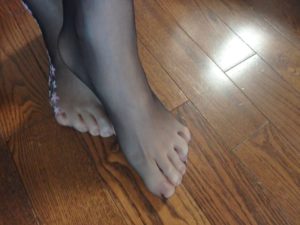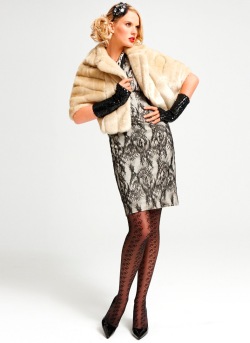 Both Gatta and Fiore brands are from Poland, with factories just a short train ride apart. They keep an eye on each other, copy each other, and so on, just like any good competitors. In general Gatta is more popular and has a wider selection. The price is quite similar.
Both Gatta and Fiore brands are from Poland, with factories just a short train ride apart. They keep an eye on each other, copy each other, and so on, just like any good competitors. In general Gatta is more popular and has a wider selection. The price is quite similar.
Today I realized that I still had one of the long time ago limited editions from Gatta called Sherry Ann. It’s been a while since I wore Gatta hosiery since I wear so much of other brands.
It is a sheer 20 den style with pink flowers along the side of the leg. Some of you who followed this blog, you probably saw this style already. It is no longer available for sale simply because I don’t have anymore of it.
I also was trying on for photos some Fiore tights in 20 denier, same size and similar kind of pattern, to compare the fit and feel. Here I’ll just show Gatta tights since I already have so many photos of Fiore.
 Here are my comments so far:
Here are my comments so far:
Lycra content: Gatta has a little more lycra! I see that Fiore usually has 12% for such styles and Gatta has 14%. In my opinion higher lycra content results in a softer feel.
Elasticity: Gatta proved to be more elastic. I tried size Large for both pairs and Fiore evenly stretched along my legs right away, but Gatta seemed to have extra material left over that rolled up on my upper thigh, later smoothing out as I continued wearing it.
 Toe reinforcement: Gatta has sheer toe, Fiore has invisibly reinforced toe. I rarely get runs, but I hear from other people that any kind of reinforcement helps with durability.
Toe reinforcement: Gatta has sheer toe, Fiore has invisibly reinforced toe. I rarely get runs, but I hear from other people that any kind of reinforcement helps with durability.
Cotton gusset: Gatta always, always, always has a gusset! Fiore will only up a gusset for sizes Medium and Large. Perhaps it’s not as crucial for fitting when it comes to a petite figure, but mainly it’s a money saver. But here is an important point, on tights checked for Gatta the gusset is synthetic and for Fiore it was made of cotton, thus being more hygienic. (This is not a rule though, both brands produce some with cotton gussets, and some styles with synthetic depending on the price.)
This is all for now. As you see, both have some advantages, disadvantage, and features that may be important for some people.


